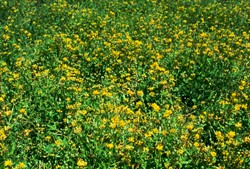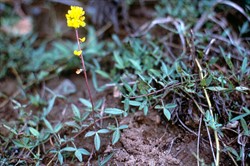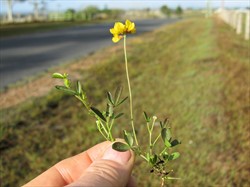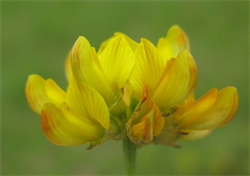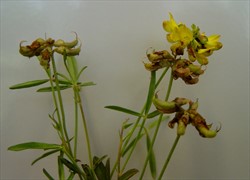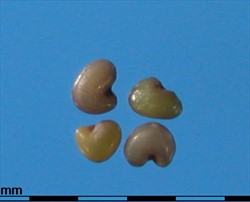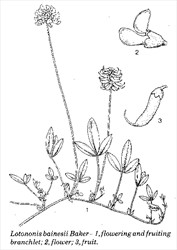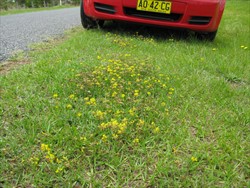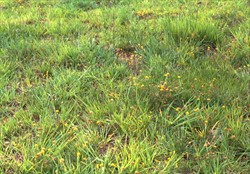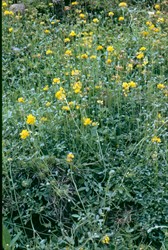Listia bainesii
Tropical Forages
Listia bainesii (Baker) B.-E. van Wyk & Boatwr.
Basionym: Lotononis bainesii Baker
Family: Fabaceae (alt. Leguminosae) subfamily: Faboideae tribe: Crotalarieae.
Mat-forming, herbaceous perennial with soft, slender, irregularly branched stolons, to 1.5 m long, with upright axillary shoots to 20 (rarely 60) cm. Strong main taproot with subsidiary taproots developing from the fibrous root system at stolon nodes. New growth finely hairy, although few hairs persisting, giving older foliage a glabrous, shiny appearance. Stipules ovate, 4‒10 mm, one smaller than other, base auriculate, apex acute. Leaves palmate, mostly trifoliolate (rarely with 4 or 5 leaflets), borne in groups of 3‒5; one or more leaves at each node large, the others much smaller; leaflets thick, fleshy, mucilaginous when crushed, polymorphic (linear, ovate, obovate, and lanceolate on any one plant), the central leaflet to 6 cm long and/or 3 cm wide; petioles 6‒50 mm long depending on defoliation pressure. Inflorescence a dense, globose or umbellate raceme (sometimes elongated), comprising 8‒25 flowers; peduncle to 15 (‒25) cm long; flowers sessile, yellow, papilionate, 8‒10 mm long, with corolla three times as long as calyx, standard and keel almost equal, the wings small and shorter. Pod 8‒12 mm long, curved linear-oblong with prominent stylar hook, many-seeded, shattering at the base to release seed. Seeds cream-yellow to light brown or magenta-rose, obovoid and asymmetrically heart-shaped, laterally compressed, 0.5‒1 mm diameter; 3‒4 million seeds per kg.
Similar species
Listia bainesii: pods straight or curved.
Lotononis listii Polhill (syn. Listia heterophylla E. Mey.): pods crimped and laterally folded.
Asia: 罗顿豆 luo dun dou (China); लोटोनोनिस बैनेसाई (India, Hindi); thua-lotononit (Thailand)
English: lotononis, creeping indigo (inappropriate, common for Indigofera spicata)
Native:
Africa: Botswana; Mozambique (south); Namibia; South Africa (Gauteng, Limpopo, Mpumalanga, North-West)
Cultivated:
Africa: Kenya; Zimbabwe
Asia: Taiwan
Australasia: Australia (Queensland, New South Wales); Papua New Guinea; China
Indian Ocean: Mauritius
South America: Uruguay
Forage
Mostly used as a grazed pasture in the subtropics, but has also produced high quality silage without the addition of molasses. Useful standover in cool areas due to frost tolerance.
Environment
Although capable of forming a dense mat, its value for soil conservation is usually limited by its ephemerality.
Other
Unsuitable for pedestrian traffic due to fleshy, mucilaginous leaves.
Soil requirements
Occurs on gravelly, sandy, and loamy soils (rarely clays) and has been found to be adapted to a wide range of predominantly well-drained soils provided there is bare ground available. Not well adapted to heavy cracking clays. Grows well on infertile soils, with low levels of P and Mo, usually performing poorly on more fertile soils where competition is greater. Performs best between pH 5 and 6, but grows from pH 4‒8.5. Tolerant of high available soil manganese and aluminium, but very low tolerance of salinity.
Moisture
Found mostly in damp grassy places in valleys, disturbed places along channels, dams and quarries, as well as in cultivated places in areas with rainfall mostly between about 300 and 700 mm/yr. In cultivation, it has done well in areas with annual rainfall as low as 750 mm (or lower at altitude) and up to about 1,600 mm. It is more drought tolerant than Desmodium intortum but not as drought tolerant as Macroptilium atropurpureum. Although perennial, it can act as an ephemeral where drought-depleted stands recover with the onset of moist conditions by virtue of high levels of soil seed. Best on well-drained soils but survives short periods of waterlogging and short-term flooding.
Temperature
Occurs naturally between 19 and 34 ºS, and mostly at altitudes above 1,200 m asl. Average annual temperatures at these sites ranges from about 15 to 18 ºC, making this a truly subtropical species. It has become naturalized in other countries in areas with average annual temperatures from 14 to 22 ºC, usually receiving winter frosts. Growth is minimal below 7.5 ºC or when the weekly mean minimum temperature falls below 9 ºC. L. bainesii is very frost tolerant for a warm season plant, with mature growth surviving grass temperature as low as -6.5 ºC, and only killed at -9 ºC. Immature growth is killed at -1 ºC. In the subtropics, it makes its best growth in the spring and autumn, if moisture is adequate.
Light
Found naturally in grassland and open woodland. Growth reduces rapidly with decreasing light.
Reproductive development
Appears to be a long day plant, flowering mainly in the spring, with a secondary blooming in late summer.
Defoliation
Under lenient grazing, L. bainesii forms a deep sward, but the growth habit is altered to a low mat under heavier grazing pressure. Disease becomes more prevalent in the humid microclimate that accompanies deep swards, which may ultimately lead to stand decline, particularly under higher rainfall conditions. It is best kept fairly closely grazed to encourage the runners to root down and to reduce damage by disease. Close grazing also reduces the adverse effect of shading from companion species. A rotation of two weeks' grazing, four weeks' rest, or a system maintaining stands around 10 cm high has been found to be successful. Lighter grazing during flowering and seeding in spring could increase the resultant development of a soil seed-bank, which is important for long-term persistence. Seed banks often reach levels of 10,000‒100,000 seeds/m².
Fire
Tolerant of fire, recovering from crowns and soil seed.
Guidelines for establishment and management of sown forages.
Establishment
L. bainesii can be planted vegetatively or from seed. Stolons can be planted on about a 1 m grid, or 15 cm square turfs on a 2.5 m × 2 m grid. Seed should be sown at 0.5‒1 kg/ha onto the surface of a fine, firm, clean seedbed, and rolled. Many plantings have failed through seed being sown too deeply, so seed must not be placed more than 5‒6 mm deep. There is little post-harvest dormancy, although hand-harvested seed has a high hard-seed content, the darker seed having a higher content than lighter-coloured seed. Hardseededness can be broken by treating seed with concentrated sulphuric acid (sp. gr. 1.8) for 20 minutes, followed by thorough washing and drying. Heat treatments are not recommended as they can have a detrimental effect on such small seed. Machine-harvested seed is adequately scarified during the harvest process. Commercial seed of L. bainesii does not keep well under non-storage conditions, and can die within a year at room temperature and humidity. The darker coloured hard seed retains viability longer than yellow or green seed. Seed must be inoculated prior to sowing in a new area, as L. bainesii is highly specific in its requirement for root nodule bacteria, nodulating with Methylobacterium sp. aff. nodulans (formerly classified as a Bradyrhizobium sp.) CB 376. Since the plant grows best at moderate temperatures and is fairly cold tolerant, it is often best sown later in the season, with the added advantage of lower evaporation rates and better soil moisture. Seedling vigour is not good and the plant is rather slow to start. Seedlings are small and initially slow growing.
Fertilizer
Grows well in infertile soils, but responds to low to moderate nutrient applications, particularly of phosphorus, but rarely calcium or molybdenum. Almost as effective as Stylosanthes humilis in extracting P from low-fertility soils.
Compatibility (with other species)
Combines well with lower growing grasses and legumes, provided there is space between plants. It generally does not grow well with sward forming grasses such as Paspalum notatum and Cenchrus clandestinus although it has been moderately successful in heavily grazed Digitaria eriantha (pangola grass) forages. Because of its unpredictable performance, it should be sown with other legumes in mixtures. Does not compete well with weeds in the seedling stage, and is susceptible to shading by tall weeds in established stands.
Companion species
Grasses: Chloris gayana, Digitaria eriantha, Heteropogon contortus, Paspalum dilatatum, P. plicatulum, Setaria sphacelata.
Legumes: Aeschynomene falcata, Chamaecrista rotundifolia, Macroptilium atropurpureum, Stylosanthes guianensis var. intermedia.
Success as companion species of most of the above is dependent on maintenance of sufficient grazing pressure to avoid the impact of shading on L. bainesii plants. (see Ecology/Defoliation section).
Pests and diseases
Main fungal diseases are leaf spot (Cercospora sp.), Sclerotium rolfsii, Fusarium and Pythium root and stolon rots, flower blight (Botrytis sp.) and Rhizoctonia solani, which can contribute to the sudden collapse of a stand, particularly with a bulk of growth in warm, humid conditions. Very susceptible to legume little-leaf disease caused by a phytoplasma carried by the common brown leafhopper (Orosius argentatus Cicadellidae), more so if it is grazed lightly in late summer. Bean yellow mosaic (poty-) virus spread by over 20 species of aphids can also be a problem. Grazing helps in minimising most disease damage.
Attacked by the spiral (Helicotylenchus dihystera) and root-knot (Meloidogyne hapla) nematodes. Main insect pests are heliothis (Helicoverpa armigera) and pod-sucking bugs such as Riptortus serripes (Alydidae) and Nezara viridula (Pentatomidae), which can be a problem in seed stands. Resistant to amnemus weevil (Amnemus quadrituberculatus).
Commonly parasitised by dodder (Cuscuta sp.) in Australia.
Ability to spread
Spreads rapidly by seed and stolons if bare soil and suitable inoculum available. Hence, extremely common on graded (scraped) roadsides in the subtropics, where it is spread by road maintenance equipment. Also spread in the dung of cattle that ingest seed.
Weed potential
Not an aggressive species, despite ability to spread.
Nutritive value
Comparable with lucerne (Medicago sativa) in nutritive value. Crude protein values range from about 9 to 26%, depending on time of year (flowering, etc.), age of regrowth and vigour of the plant, but is commonly in the high end of the range. Levels can be improved through application of superphosphate. IVDMD is about 60%. Sodium content is higher than that in many tropical legumes. Calcium levels in a well fertilized stand ranged from 0.6 to 0.7% of the DM, and P levels from 0.3 to 0.4%.
Palatability/acceptability
Extremely palatable, selected over many other tropical species.
Toxicity
No toxicity reported. Can cause milk taint.
Feedipedia link
Dry matter
DM yields of pure stands are of the order of 5‒8 t/ha under good conditions, and 1‒3 t/ha in association with grass. Main growth is produced in the early and latter part of the season if moisture is adequate.
There is a natural but very significant fluctuation in frequency (and yield) in pastures as stands succumb to disease, drought etc., and respond to better conditions such as cool moist conditions following a dry winter.
Animal production
No information available.
A tetraploid (2n = 36). Initially reported to be cleistogamous (self-pollinated). More recent research suggests that fertilization in L. bainesii is chasmogamous and highly allogamous, needing pollinators to produce seed, and that genotypes exist that are self-incompatible. Crop management and harvesting techniques are crucial to successful seed production.
Initially seed was hand harvested or collected with a mower. Commercial seed is machine harvested by direct heading or mowing, windrowing and threshing. Harvest procedures are fairly inefficient, usually yielding 25‒55 kg/ha (and up to 110 kg/ha) of a possible 300‒400 kg/ha in the standing crop. Crops are harvested when about 80% of the crop has purple seed.
L. bainesii is tolerant of fluazifop-butyl and sethoxydim, but susceptible to acifluorfen, bentazone, 2,4-D and 2,4-DB.
- Adapted to infertile soils.
- Frost tolerance and cool season growth .
- Tolerance of waterlogging.
- Tolerance of heavy grazing.
- High palatability and quality.
- Drought tolerance.
- Resistance to amnemus weevil.
- Susceptible to disease.
- Ephemeral behaviour.
- Low seed yields lead to expensive seed.
- Small seed difficult to establish.
- Initial seedling growth slow
- Not competitive.
Bogdan, A.V. (1977) Tropical Pasture and Fodder Plants. Longman Inc., New York, USA. p. 374–379.
Bryan, W.A., Sharpe, J.P. and Haydock, K.P. (1971) Some factors affecting the growth of lotononis (Lotononis bainesii). Australian Journal of Experimental Agriculture and Animal Husbandry 11:29–34. doi.org/10.1071/EA9710029
Bryan, W.W. (1961) Lotononis bainesii Baker - a legume for sub-tropical pastures. Australian Journal of Experimental Agriculture and Animal Husbandry 1:4–10. doi.org/10.1071/EA9610004
Cameron, D.G. (1985) Tropical and subtropical pasture legumes 6. Lotononis (Lotononis bainesii): A very useful but enigmatic legume. Queensland Agricultural Journal 111:69–72.
Jones, R.M. (1992) Lotononis bainesii Baker. In: Mannetje, L.’t and Jones, R.M. (eds) Plant Resources of South-East Asia No. 4. Forages. Pudoc Scientific Publishers, Wageningen, the Netherlands. p. 148–149. edepot.wur.nl/327785
Pott, A. and Humphreys, L.R. (1983) Persistence and growth of Lotononis bainesii -Digitaria decumbens pastures: 1. Sheep stocking rate. The Journal of Agricultural Science 101:1–7. doi.org/10.1017/S0021859600036297
Real, D. and Altier, N. (2004) Breeding for disease resistance, forage and seed production in Lotononis bainesii Baker. New Zealand Journal of Agricultural Research 48:93–100. doi.org/10.1080/00288233.2005.9513636
Real, D., Rizza, M.D., Quesenberry, K.H. and Echenique, M. (2004) Reproductive and molecular evidence for allogamy in Lotononis bainesii Baker. Crop Science 44:394–400. doi.org/10.2135/cropsci2004.3940
Van Wyk, B.E. (1991) A Synopsis of the Genus Lotononis (Fabaceae: Crotalarieae). Contributions from the Bolus Herbarium 14. Rustica Press, Wynberg, South Africa.
'Beit' Released in Zimbabwe (1972). No information available.
'INIA Glencoe' Released in Uruguay (2002). A bred variety, selected for resistance to Fusarium oxysporum crown and stolon rot, forage production in the subtropics (particularly on basaltic soils), and seed production. Ninety crosses were generated from 581 emasculated inflorescences from 15 parent plants from 9 seed sources. More resistant to fusarium and higher seed yields than 'Miles'.
'Miles' (CPI 16833) Released in Australia (1966). Selected for adaptation to poor soils in frosted, coastal and sub-coastal subtropics. Largely the basis for agronomic details in preceding text.
None reported.
